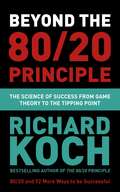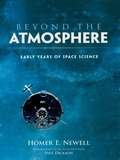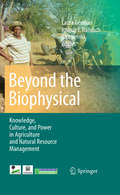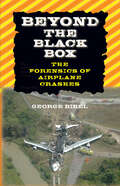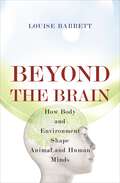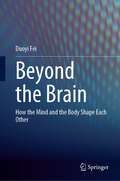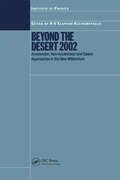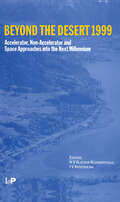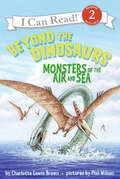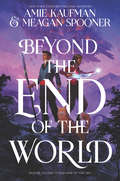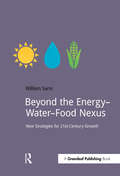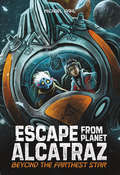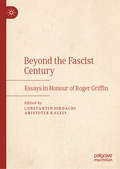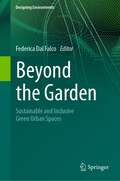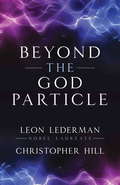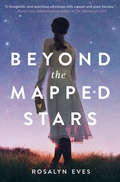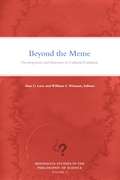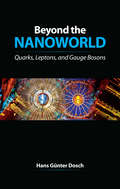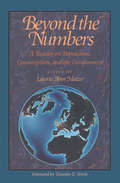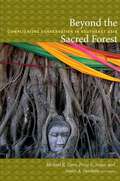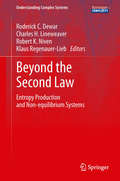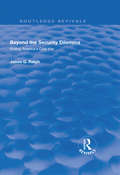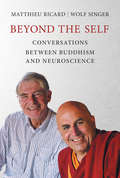- Table View
- List View
Beyond the 80/20 Principle: The Science of Success from Game Theory to the Tipping Point
by Richard KochMillions of highly effective people around the world have read Richard Koch's global bestseller THE 80/20 PRINCIPLE and enjoyed a serious advantage in the pursuit of success. Now, BEYOND THE 80/20 PRINCIPLE (previously published as The 80/20 Principle and 92 Other Powerful Laws of Nature) takes you even further.Including the 80/20 Principle itself - the radical power law that helps you achieve more by doing less - BEYOND THE 80/20 PRINCIPLE reveals 92 more universal scientific principles and laws that will help you achieve personal success in an increasingly challenging business environment.From natural selection to genes and memes, BEYOND THE 80/20 PRINCIPLE demonstrates, in theory and in practice, what science can teach you about business and success. It includes: * Evolution by Natural Selection * Business Genes * Gause's Laws * Evolutionary Psychology * Newton's Laws * Relativity * Quantum Mechanics * Chaos * Complexity * The Tipping Point * Increasing Returns * Unintended Consequences'Richard Koch delivers some sharp cross-disciplinary comparisons and knows his onions on both sides of the business/science fence... Koch's feet are firmly on the ground' THE SUNDAY TIMES - Business Book of the Week'Cogently, entertainingly and often controversially, [Koch] draws parallels between the natural universe and the modern business world. Persevere with Koch's often elegant thought processes and you will look at your business quite differently' ENTERPRISE
Beyond the Atmosphere: Early Years of Space Science
by Homer E. Newell Jr.This exciting survey of the American space science program is the work of a top NASA administrator. Ranging from the laboratory to launching pad and from international conference halls to lunar wastelands, it chronicles technological advances, explores the relationship of space science to general science, and places the space program in a broader social, political, and economic context. Homer E. Newell was instrumental in the founding of NASA and worked for the agency from its inception until 1973. In the early 1960s, he influenced or directly controlled virtually all of the free world's nonmilitary unmanned space missions. Newell's insider perspective offers fascinating insights into the personalities, opinions, and steady advance of ideas that characterize the U.S. space program.
Beyond the Biophysical: Knowledge, Culture, and Power in Agriculture and Natural Resource Management
by Ritu Verma Laura German Joshua J. RamischBeyond the Biophysical provides a broad overview of agriculture and natural resource management (NRM) scholarship and practice that lies beyond the biophysical, emphasizing instead epistemological, cultural, and political foundations of NRM. The volume is oriented toward professionals with expertise in agriculture and natural resource management scholarship and practice, but who lack exposure to the conceptual and methodological underpinnings of critical theory, the anthropology of development, ecological anthropology, and other relevant scholarship. It therefore follows common standards of academic rigour, but minimizes the use of jargon, integrates detailed case studies with conceptual syntheses, and attempts to move from critique to concrete recommendations for scholarship and practice. The volume seeks to foster a more nuanced and responsible engagement with local communities and the natural world among NRM scholars and practitioners.
Beyond the Black Box: The Forensics of Airplane Crashes
by George BibelThe black box is orange—and there are actually two of them. They house the cockpit voice recorder and the flight data recorder, instruments vital to airplane crash analyses.But accident investigators cannot rely on the black boxes alone. Beginning with the 1931 Fokker F-10A crash that killed legendary football coach Knute Rockne, this fascinating book provides a behind-the-scenes look at plane wreck investigations. Professor George Bibel shows how forensic experts, scientists, and engineers analyze factors like impact, debris, loading, fire patterns, metallurgy, fracture, crash testing, and human tolerances to determine why planes fall from the sky—and how the information gleaned from accident reconstruction is incorporated into aircraft design and operation to keep commercial aviation as safe as possible.
Beyond the Brain: How Body and Environment Shape Animal and Human Minds
by Louise BarrettA new approach to understanding animal and human cognitionWhen a chimpanzee stockpiles rocks as weapons or when a frog sends out mating calls, we might easily assume these animals know their own motivations--that they use the same psychological mechanisms that we do. But as Beyond the Brain indicates, this is a dangerous assumption because animals have different evolutionary trajectories, ecological niches, and physical attributes. How do these differences influence animal thinking and behavior? Removing our human-centered spectacles, Louise Barrett investigates the mind and brain and offers an alternative approach for understanding animal and human cognition. Drawing on examples from animal behavior, comparative psychology, robotics, artificial life, developmental psychology, and cognitive science, Barrett provides remarkable new insights into how animals and humans depend on their bodies and environment—not just their brains—to behave intelligently.Barrett begins with an overview of human cognitive adaptations and how these color our views of other species, brains, and minds. Considering when it is worth having a big brain—or indeed having a brain at all—she investigates exactly what brains are good at. Showing that the brain's evolutionary function guides action in the world, she looks at how physical structure contributes to cognitive processes, and she demonstrates how these processes employ materials and resources in specific environments.Arguing that thinking and behavior constitute a property of the whole organism, not just the brain, Beyond the Brain illustrates how the body, brain, and cognition are tied to the wider world.
Beyond the Brain: How the Mind and the Body Shape Each Other
by Duoyi FeiDifferent from traditional research on the mind-body problem often discussed from an epistemological viewpoint, which assumes that mental processes are internal to the person, this book demonstrates the crucial role of contextual relevance in the workings of the mind and illustrates how mind emerges from the individual's interactions with her physical, social, and cultural environments. It also develops the interpersonal and social aspects of embodied mind. The body that creates meaning is not only an emotional, kinesthetic, and aesthetically experiencing body; the body that creates meaning is a social body. It suggests that mind-body relations are not only achieved through the interaction between our own mind and body, but by other minds in our intersubjective interactions. It is related to epistemology, metaphysics, ethics, value theory, action theory, and the philosophies of mind, science, logic, and technology. The readership may include graduate and undergraduate students studying philosophy, law, political science, sociology, psychology, etc., educators, researchers, scholars, and anyone who shows an interest in philosophy.
Beyond the Desert 2002: Accelerator, Non-Accelerator and Space Approaches in the New Millennium
by H V Klapdor-KleingrothausContaining the Proceedings of the Third International Conference on Physics Beyond the Standard Model, this book reports the latest experimental and theoretical results and ideas in this exciting field, at the interface between particle physics, astrophysics, and nuclear physics. Taken as a whole, this book presents an overview of the current statu
Beyond the Desert 99: Accelerator, Non-accelerator and Space Approaches into the Next Millennium, Second International Conference on Particle Physics Beyond the Standard Model, Castle Ringberg, Germany, 6-12 June 1999
by H V Klapdor-Kleingrothaus I V KrivosheinaAddressing the need for an up-to-date reference on silicon devices and heterostructures, Beyond the Desert 99 reviews the technology used to grow and characterize Goup IV alloy films. It covers the theory, device design, and simulation of heterojunction transistors, emphasizing their relevance in developing the technologies involving strained layer
Beyond the Dinosaurs: Monsters of the Air and Sea (I Can Read Level 2)
by Charlotte Lewis BrownAmazing creatures flew through the air and swam in the seas during the Age of the Dinosaurs! Strange and wonderful creatures shared the Earth with the dinosaurs. Kronosaurus ruled the seas with teeth as big as bananas and jaws more powerful than a Tyrannosaurs-rex’s. Flying Pterodaustros spit water through hundreds of long, thin teeth. Deinosuchus, the giant crocodile, preyed on unlucky dinosaurs. These and other amazing animals are introduced to young readers in an easy-to-read text and dynamic illustrations.Beyond the Dinosaurs is a Level Two I Can Read, geared for kids who read on their own but still need a little help. Whether shared at home or in a classroom, the engaging stories, longer sentences, and language play of Level Two books are proven to help kids take their next steps toward reading success.
Beyond the End of the World
by Amie Kaufman Meagan SpoonerPerfect for fans of Brandon Sanderson and Laini Taylor, this much-anticipated sequel to New York Times bestselling authors Amie Kaufman and Meagan Spooner’s The Other Side of the Sky is a thrilling race against time—with a tantalizing star-crossed love and an electric conclusion.Time to find a way between worlds. Time to find each other again. Time to do the impossible.Above, in the cloudlands, Nimh has no memory of her past, only an aching, undying certainty that she has left something—someone—behind. But while she struggles to recall her identity, an imposter wields her name with deadly purpose.Below, on the surface, North looks to the sky, desperate to join the person he loves and return to his world. But with only a traitor willing to help him, and others clamoring for him to take Nimh’s place, his home seems more unreachable than ever.Tragedy looms as the cloudland engines falter and mist rains terror on the surface, and in their desperation to reunite and save their people, Nimh and North face one ultimate question: can they defy their love and their destiny to save their homes?Or will the spark between them ignite their worlds, and consume them all together?Praise for The Other Side of the Sky: "Amie Kaufman and Meagan Spooner prove they are two living goddesses of writing, creating two compelling worlds with high stakes and gripping emotions." —Sarah Rees Brennan, New York Times bestselling author of the Demons Lexicon trilogy and the Lynburn Legacy series“A vivid and compulsive thriller set in a beautiful, perilous world of myths and treachery. You won’t want to put it down.” —Laini Taylor, New York Times bestselling author of the Daughter of Smoke and Bone series“I was left breathless by the book’s twists and turns, and was unprepared for the ending—it blew me away. Stop everything and read it!” —C. S. Pacat, bestselling author of Dark Rise“A book that absolutely shimmers with beauty.” —Buzzfeed
Beyond the Energy–Water–Food Nexus: New Strategies for 21st-Century Growth (Doshorts Ser.)
by Will SarniProviding food, clean water and energy for a growing population is one of the greatest challenges facing public and private sector professionals. While there is widespread recognition of the complex feedback loops between energy, water and food, there has been less focus on viable solutions. This guide by Will Sarni – an internationally recognized thought leader on corporate water stewardship and water tech innovation – frames the key issues and challenges for business professionals, and then outlines emerging solutions which include both "soft path" and technology innovation approaches. The book includes case examples of multinational companies who are abandoning business as usual and moving beyond traditional thinking. It also highlights crucial new partnerships or "collective action initiatives" where NGOs, multinationals and the public sector come together to forge practical solutions to meet the needs of their stakeholders. Solutions to the energy–water–food nexus will need to be disruptive, not incremental, and will require technology innovation, new public–private partnerships, and changes in public policy. Beyond the Energy–Food–Water Nexus shows organizations how they can play their part in improving the quality of life for an urbanized global population while preserving the ecosystems that sustain us all.
Beyond the European Left: Ideology and Political Action in the Belgian Ecology
by Herbert Kitschelt Staf HellemansDrawing on recent research on the internal politics of the Belgian ecology parties, Agalev and Ecolo, this work demonstrates how political careers in contemporary social movements lead to activism in left-libertarian politics and influence political ideology. Beyond the European Left is the first comprehensive survey of ecology parties in Europe that presents detailed empirical information on the careers, organizational practices, and political beliefs of the activists involved.The authors employ a new research methodology--surveying party militants--that is better adapted to the study of micropolitics than are expert interviews. Herbert Kitschelt and Staf Hallemans show that European Green party activists express an egalitarian and libertarian vision of a desirable social order that builds on, but radically transforms, ideas of the traditional socialist European left. The authors then examine the debates and disagreements among militants on political objectives and the consequences of conflicting views for party organization and strategy. Their findings illuminate the unique dynamics of left-libertarian politics in a number of Western European countries with obvious relevance to current developments in Eastern Europe.
Beyond the Farthest Star (Escape from Planet Alcatraz)
by Michael DahlZak Nine and his Quom friend, Erro, are desperate to get off planet Alcatraz. The boys believe they've finally found a way to freedom when they join up with another prisoner. Together with their new partner, the boys board a small spacecraft and fly off the planet, past the metal moon, and head into space. But when the stars begin to look strange, Zak and Erro realize that something is very wrong. What will happen when the boys learn Planet Alcatraz's biggest secret? Will they ever get to return home?
Beyond the Fascist Century: Essays in Honour of Roger Griffin
by Constantin Iordachi Aristotle KallisThis book evaluates the current and future state of fascism studies, reflecting on the first hundred years of fascism and looking ahead to a new era in which fascism studies increasingly faces fresh questions concerning its relevance and the potential reappearance of fascism. This wide-ranging work celebrates Roger Griffin’s contributions to fascism studies – in conceptual and definitional terms, but also in advancing our understanding of fascism – which have informed related research in a number of fields and directions since the 1990s. Bringing together three ‘generations’ of fascism scholars, the book offers a combination of broad conceptual essays and contributions focusing on particular themes and facets of fascism. The book features chapters, which, although diverse in their approaches, explore Griffin’s work while also engaging critically with other schools of thought. As such, it identifies new avenues of research in fascism studies, placing Griffin’s work within the context of new and emerging voices in the field.
Beyond the Garden: Sustainable and Inclusive Green Urban Spaces (Designing Environments)
by Federica Dal FalcoThe book addresses the interdisciplinary and multiscale theme of the design of sustainable, inclusive and creative urban green spaces in relation to the socio-ecological transition and in line with the systemic vision promoted by the 2030 Agenda, the 17 Sustainable Development Goals (SDGs) and the principles outlined by the New European Bauhaus (European Commission, 2021). The publication refers to the International Study Day organized in June 2022 by the Unit for Internationalization of the PDTA Department of the Sapienza University of Rome, develops and updates its themes, with essays that deepen theories and methodologies pursued in specific disciplinary and research fields, and with case studies of design experiments and achievements that constitute best practices at an international level in the sign of a conscious sustainability. The book is therefore part of an international and interdisciplinary dialogue and discussion focused on the challenges of climate change, economic crises and social inequalities as well as the questions that emerged during the Covid-19 pandemic. These issues are fundamental in the rethinking and reconfiguration of the role of urban green spaces, conceived as a priority place for the existence of citizens, the archetype of European culture, the conservation of biodiversity, and the relationship with nature.
Beyond the God Particle
by Christopher T. Hill Leon M. LedermanTwo leading physicists discuss the importance of the Higgs Boson, the future of particle physics, and the mysteries of the universe yet to be unraveled. On July 4, 2012, the long-sought Higgs Boson--aka "the God Particle"--was discovered at the world's largest particle accelerator, the LHC, in Geneva, Switzerland. On March 14, 2013, physicists at CERN confirmed it. This elusive subatomic particle forms a field that permeates the entire universe, creating the masses of the elementary particles that are the basic building blocks of everything in the known world--from viruses to elephants, from atoms to quasars. Starting where Nobel Laureate Leon Lederman's bestseller The God Particle left off, this incisive new book explains what's next. Lederman and Hill discuss key questions that will occupy physicists for years to come: * Why were scientists convinced that something like the "God Particle" had to exist? * What new particles, forces, and laws of physics lie beyond the "God Particle"? * What powerful new accelerators are now needed for the US to recapture a leadership role in science and to reach "beyond the God Particle," such as Fermilab's planned Project-X and the Muon Collider? Using thoughtful, witty, everyday language, the authors show how all of these intriguing questions are leading scientists ever deeper into the fabric of nature. Readers of The God Particle will not want to miss this important sequel.
Beyond the Mapped Stars
by Rosalyn EvesA sweeping adventure, set in the late 19th century, about science, love, and finding your place in the world, perfect for fans of Ruta Sepetys and Julie Berry.Seventeen-year-old Elizabeth Bertelsen dreams of becoming an astronomer, but she knows such dreams are as unreachable as the stars she so deeply adores. As a Mormon girl, her duty is to her family and, in a not too far away future, to the man who'll choose to marry her.When she unexpectedly finds herself in Colorado, she's tempted by the total eclipse of the sun that's about to happen--and maybe even meeting up with the female scientists she's long admired. Elizabeth must learn to navigate this new world of possibility: with her familial duties and faith tugging at her heartstrings, a new romance on the horizon, and the study of the night sky calling to her, she can't possibly have it all...can she?
Beyond the Meme: Development and Structure in Cultural Evolution (Minnesota Studies in the Philosophy of Science #22)
by Alan C. Love William C. WimsattInterdisciplinary perspectives on cultural evolution that reject meme theory in favor of a complex understanding of dynamic change over time How do cultures change? In recent decades, the concept of the meme, posited as a basic unit of culture analogous to the gene, has been central to debates about cultural transformation. Despite the appeal of meme theory, its simplification of complex interactions and other inadequacies as an explanatory framework raise more questions about cultural evolution than it answers. In Beyond the Meme, William C. Wimsatt and Alan C. Love assemble interdisciplinary perspectives on cultural evolution, providing a nuanced understanding of it as a process in which dynamic structures interact on different scales of size and time. By focusing on the full range of evolutionary processes across distinct contexts, from rice farming to scientific reasoning, this volume demonstrates how a thick understanding of change in culture emerges from multiple disciplinary vantage points, each of which is required to understand cultural evolution in all its complexity. The editors provide an extensive introductory essay to contextualize the volume, and Wimsatt contributes a separate chapter that systematically organizes the conceptual geography of cultural processes and phenomena.Any adequate account of the transmission, elaboration, and evolution of culture must, this volume argues, recognize the central roles that cognitive and social development play in cultural change and the complex interplay of technological, organizational, and institutional structures needed to enable and coordinate these processes.Contributors: Marshall Abrams, U of Alabama at Birmingham; Claes Andersson, Chalmers U of Technology; Mark A. Bedau, Reed College; James A. Evans, U of Chicago; Jacob G. Foster, U of California, Los Angeles; Michel Janssen, U of Minnesota; Sabina Leonelli, U of Exeter; Massimo Maiocchi, U of Chicago; Joseph D. Martin, U of Cambridge; Salikoko S. Mufwene, U of Chicago; Nancy J. Nersessian, Georgia Institute of Technology and Harvard U; Paul E. Smaldino, U of California, Merced; Anton Törnberg, U of Gothenburg; Petter Törnberg, U of Amsterdam; Gilbert B. Tostevin, U of Minnesota.
Beyond the Nanoworld: Quarks, Leptons, and Gauge Bosons
by H. G. DoschBeyond the world of atoms, at scales smaller than the smallest nuclei, a new world comes into view, populated by an array of colorful elementary particles: strange and charmed quarks, muons and neutrinos, gluons and photons, and many others, all interacting in beautifully intricate patterns. Beyond the Nanoworld tells the story of how this new real
Beyond the Numbers: A Reader on Population, Consumption and the Environment
by Judy Norsigian Sharon Stanton Russell G. Rathjens J. Boutwell Adrienne Germain David E. HorlacherBeyond the Numbers presents a thought-provoking series of essays by leading authorities on issues of population and consumption. The essays both define the poles of debate and explore common ground beyond the polarized rhetoric.Specific chapters consider each of the broad topics addressed at the International Conference on Population and Development held in September 1994 in Cairo, Egypt. The essays are supplemented by sidebars and short articles featuring more-impassioned voices that highlight issues of interest not fully explored in the overviews.As well as providing a sense of the difficulties involved in dealing with these issues, the essays make clear that constructive action is possible.Topics covered include: the interrelationships between population, economic growth, consumption, and development the history of population and family planning efforts gender equality and the empowerment of women reproductive rights, reproductive health, family planning, health and mortality
Beyond the Sacred Forest: Complicating Conservation in Southeast Asia
by Michael R. Dove Percy E. Sajise Amity A. DoolittleReflecting new thinking about conservation in Southeast Asia, Beyond the Sacred Forest is the product of a unique, decade-long, interdisciplinary collaboration involving research in Indonesia, Malaysia, and the Philippines. Scholars from these countries and the United States rethink the translation of environmental concepts between East and West, particularly ideas of nature and culture; the meaning of conservation; and the ways that conservation policy is applied and transformed in the everyday landscapes of Southeast Asia. The contributors focus more on folk, community, and vernacular conservation discourses than on those of formal institutions and the state. They reject the notion that conservation only takes place in bounded, static, otherworldly spaces such as protected areas or sacred forests. Thick with ethnographic detail, their essays move beyond the forest to agriculture and other land uses, leave behind orthodox notions of the sacred, discard outdated ideas of environmental harmony and stasis, and reject views of the environment that seek to avoid or escape politics. Natural-resource managers and policymakers who work with this more complicated vision of nature and culture are likely to enjoy more enduring success than those who simply seek to remove the influence and impact of humans from conserved landscapes. As many of the essays suggest, this requires the ability to manage contradictions, to relinquish orthodox ideas of what conservation looks like, and to practice continuously adaptive management techniques. Contributors. Upik Djalins, Amity A. Doolittle, Michael R. Dove, Levita Duhaylungsod, Emily E. Harwell, Jeyamalar Kathirithamby-Wells, Lye Tuck-Po, Percy E. Sajise, Endah Sulistyawati, Yunita T. Winarto
Beyond the Second Law: Entropy Production and Non-equilibrium Systems (Understanding Complex Systems)
by Charles H. Lineweaver Roderick C. Dewar Robert K. Niven Klaus Regenauer-LiebThe Second Law, a cornerstone of thermodynamics, governs the average direction of dissipative, non-equilibrium processes. But it says nothing about their actual rates or the probability of fluctuations about the average. This interdisciplinary book, written and peer-reviewed by international experts, presents recent advances in the search for new non-equilibrium principles beyond the Second Law, and their applications to a wide range of systems across physics, chemistry and biology. Beyond The Second Law brings together traditionally isolated areas of non-equilibrium research and highlights potentially fruitful connections between them, with entropy production playing the unifying role. Key theoretical concepts include the Maximum Entropy Production principle, the Fluctuation Theorem, and the Maximum Entropy method of statistical inference. Applications of these principles are illustrated in such diverse fields as climatology, cosmology, crystal growth morphology, Earth system science, environmental physics, evolutionary biology and technology, fluid turbulence, microbial biogeochemistry, plasma physics, and radiative transport, using a wide variety of analytical and experimental techniques. Beyond The Second Law will appeal to students and researchers wishing to gain an understanding of entropy production and its central place in the science of non-equilibrium systems - both in detail and in terms of the bigger picture.
Beyond the Security Dilemma: Ending America's Cold War (Routledge Revivals)
by Jason G. RalphThis title was first published in 2001. The security dilemma has long been at the heart of the security studies discipline. Moving beyond this, this book attacks the assumptions of the traditional concept and redefines the security dilemma in a way more useful for examining security policy. By exposing the historical and social contingency of the traditional concept, the book argues that the security dilemma is an important though not a permanently operating feature of international politics. An examination of US policy towards the Soviet Union demonstrates the limits of perceiving the Cold War and challenges the role that American security policy has played in the process of constructing a transatlantic security community.
Beyond the Self: Conversations between Buddhism and Neuroscience (The\mit Press Ser.)
by Matthieu Ricard Wolf SingerConverging and diverging views on the mind, the self, consciousness, the unconscious, free will, perception, meditation, and other topics.Buddhism shares with science the task of examining the mind empirically; it has pursued, for two millennia, direct investigation of the mind through penetrating introspection. Neuroscience, on the other hand, relies on third-person knowledge in the form of scientific observation. In this book, Matthieu Ricard, a Buddhist monk trained as a molecular biologist, and Wolf Singer, a distinguished neuroscientist—close friends, continuing an ongoing dialogue—offer their perspectives on the mind, the self, consciousness, the unconscious, free will, epistemology, meditation, and neuroplasticity. Ricard and Singer's wide-ranging conversation stages an enlightening and engaging encounter between Buddhism's wealth of experiential findings and neuroscience's abundance of experimental results. They discuss, among many other things, the difference between rumination and meditation (rumination is the scourge of meditation, but psychotherapy depends on it); the distinction between pure awareness and its contents; the Buddhist idea (or lack of one) of the unconscious and neuroscience's precise criteria for conscious and unconscious processes; and the commonalities between cognitive behavioral therapy and meditation. Their views diverge (Ricard asserts that the third-person approach will never encounter consciousness as a primary experience) and converge (Singer points out that the neuroscientific understanding of perception as reconstruction is very like the Buddhist all-discriminating wisdom) but both keep their vision trained on understanding fundamental aspects of human life.
Beyond the Solar System: Exploring Galaxies, Black Holes, Alien Planets, and More; A History with 21 Activities
by Mary Kay CarsonTracing the evolution of humankind's pursuit of astronomical knowledge, this resource looks deep into the furthest reaches of space. Children will follow along as the realization that the Earth is not at the center of the universe leads all the way up to recent telescopic proof of planets orbiting stars outside the solar system. In addition to its engaging history, this book contains 21 hands-on projects to further explore the subjects discussed. Readers will build a three-dimensional representation of the constellation Orion, see how the universe expands using an inflating balloon, and construct a reflecting telescope out of a makeup mirror and a magnifying glass. It also includes small biographies of famous astronomers, a time line of major scientific discoveries, a glossary of technical terms, and dozens of full-color images taken by the Hubble Space Telescope and the Chandra X-Ray Observatory.
